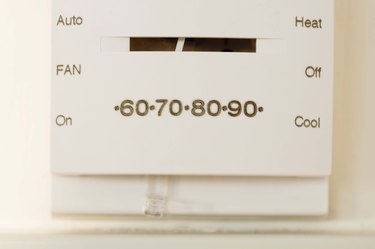
Your home's heating system is designed to keep its temperature within a set range. While the thermostat may be set for a specific temperature, the furnace works to keep the inside of the home within a few degrees of your setting. It does this to reduce the start and stop cycles of the furnace, thus extending its life. If the heating system overheats the building before shutting down, it is most likely a problem with the thermostat settings.
Step 1
Find the home's thermostat. For it to operate properly, it should be in the center of the building, on an interior wall, and on the first floor. There should be no sources of heat close to it such as fireplaces, furnace registers and stoves. If one of these conditions exist, have the thermostat moved to a better location.
Video of the Day
Step 2
Open your furnace owner's manual and locate the required anticipator setting using its table of contents. This number is recorded in amps.
Step 3
Remove the cover from the thermostat and locate the anticipator setting. This is typically a metal arrow pointing to list of numbers.
Step 4
Move the arrow to the correct anticipator setting as stated in the furnace's owner's manual.
Step 5
Run the furnace and check to see if the temperature overshoot has been corrected. If it has not, adjust the anticipator dial to a higher number. This shuts down the furnace at a lower temperature.
Warning
Adjusting your furnace's controls incorrectly can damage your heating system. Hire a professional HVAC technician to adjust the furnace.
Video of the Day